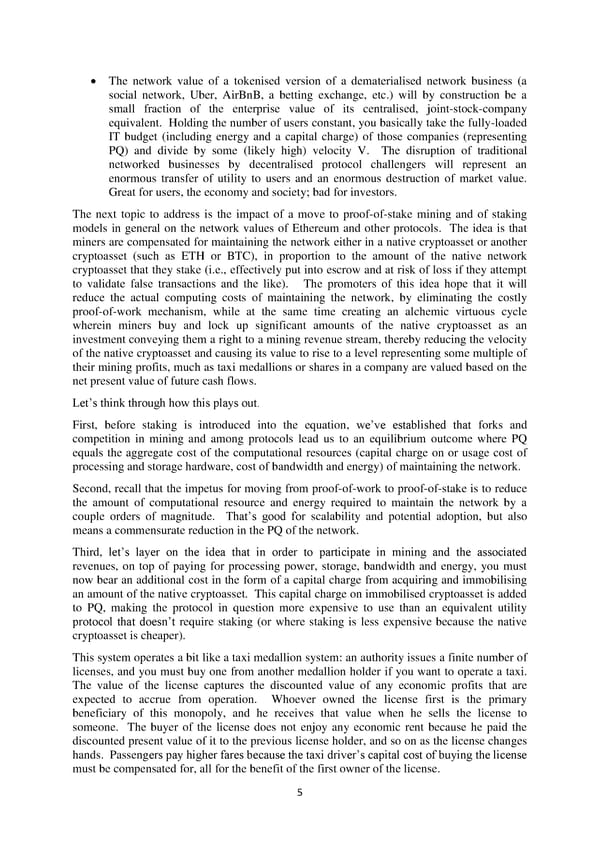• The network value of a tokenised version of a dematerialised network business (a social network, Uber, AirBnB, a betting exchange, etc.) will by construction be a small fraction of the enterprise value of its centralised, joint-stock-company equivalent. Holding the number of users constant, you basically take the fully-loaded IT budget (including energy and a capital charge) of those companies (representing PQ) and divide by some (likely high) velocity V. The disruption of traditional networked businesses by decentralised protocol challengers will represent an enormous transfer of utility to users and an enormous destruction of market value. Great for users, the economy and society; bad for investors. The next topic to address is the impact of a move to proof-of-stake mining and of staking models in general on the network values of Ethereum and other protocols. The idea is that miners are compensated for maintaining the network either in a native cryptoasset or another cryptoasset (such as ETH or BTC), in proportion to the amount of the native network cryptoasset that they stake (i.e., effectively put into escrow and at risk of loss if they attempt to validate false transactions and the like). The promoters of this idea hope that it will reduce the actual computing costs of maintaining the network, by eliminating the costly proof-of-work mechanism, while at the same time creating an alchemic virtuous cycle wherein miners buy and lock up significant amounts of the native cryptoasset as an investment conveying them a right to a mining revenue stream, thereby reducing the velocity of the native cryptoasset and causing its value to rise to a level representing some multiple of their mining profits, much as taxi medallions or shares in a company are valued based on the net present value of future cash flows. Let’s think through how this plays out. First, before staking is introduced into the equation, we’ve established that forks and competition in mining and among protocols lead us to an equilibrium outcome where PQ equals the aggregate cost of the computational resources (capital charge on or usage cost of processing and storage hardware, cost of bandwidth and energy) of maintaining the network. Second, recall that the impetus for moving from proof-of-work to proof-of-stake is to reduce the amount of computational resource and energy required to maintain the network by a couple orders of magnitude. That’s good for scalability and potential adoption, but also means a commensurate reduction in the PQ of the network. Third, let’s layer on the idea that in order to participate in mining and the associated revenues, on top of paying for processing power, storage, bandwidth and energy, you must now bear an additional cost in the form of a capital charge from acquiring and immobilising an amount of the native cryptoasset. This capital charge on immobilised cryptoasset is added to PQ, making the protocol in question more expensive to use than an equivalent utility protocol that doesn’t require staking (or where staking is less expensive because the native cryptoasset is cheaper). This system operates a bit like a taxi medallion system: an authority issues a finite number of licenses, and you must buy one from another medallion holder if you want to operate a taxi. The value of the license captures the discounted value of any economic profits that are expected to accrue from operation. Whoever owned the license first is the primary beneficiary of this monopoly, and he receives that value when he sells the license to someone. The buyer of the license does not enjoy any economic rent because he paid the discounted present value of it to the previous license holder, and so on as the license changes hands. Passengers pay higher fares because the taxi driver’s capital cost of buying the license must be compensated for, all for the benefit of the first owner of the license. 5
 Investor’s Take on Cryptoassets by John Pfeffer Page 4 Page 6
Investor’s Take on Cryptoassets by John Pfeffer Page 4 Page 6